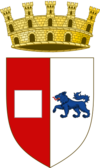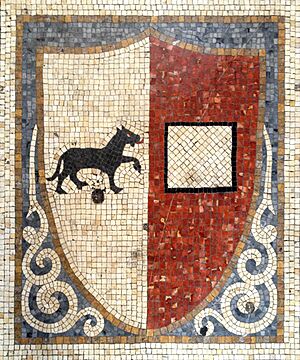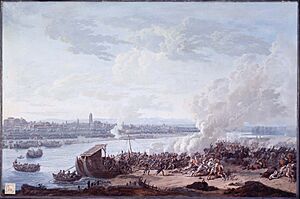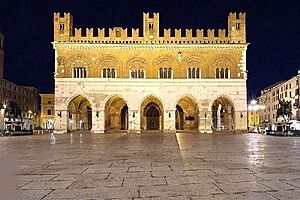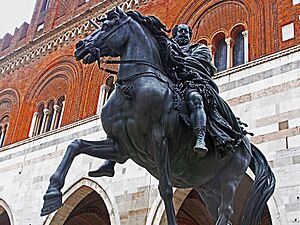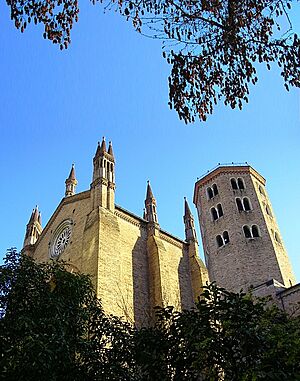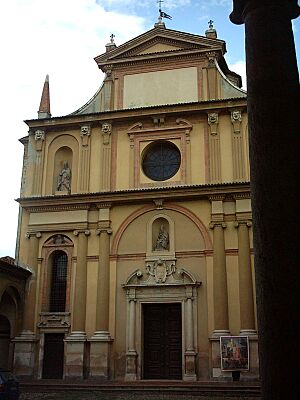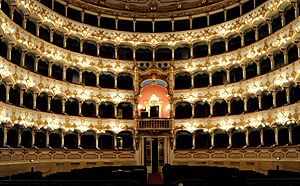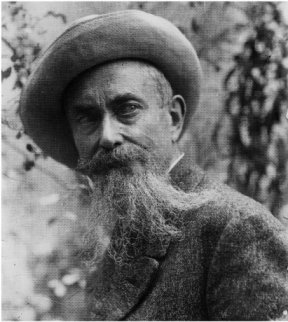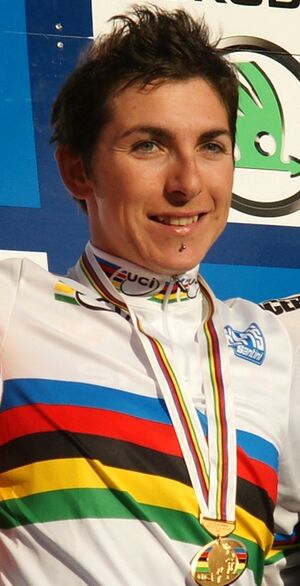Piacenza facts for kids
Quick facts for kids
Piacenza
Piaṡëinsa (Emilian)
|
|||
|---|---|---|---|
| Comune di Piacenza | |||
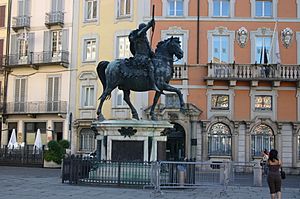
Francesco Mochi's 1615 equestrian statue of Ranuccio II Farnese, Duke of Parma, in the city's main square, Piazza Cavalli
|
|||
|
|||
| Country | Italy | ||
| Region | Emilia-Romagna | ||
| Province | Piacenza (PC) | ||
| Frazioni | Vallera, San Bonico, Pittolo, La Verza, Mucinasso, I Vaccari, Roncaglia, Montale, Borghetto, Le Mose, Mortizza, Gerbido | ||
| Area | |||
| • Total | 118.46 km2 (45.74 sq mi) | ||
| Elevation | 61 m (200 ft) | ||
| Population
(31-5-2020)
|
|||
| • Total | 103,607 | ||
| • Density | 874.62/km2 (2,265.24/sq mi) | ||
| Demonym(s) | Piacentino | ||
| Time zone | UTC+1 (CET) | ||
| • Summer (DST) | UTC+2 (CEST) | ||
| Postal code |
29121-29122
|
||
| Dialing code | 0523 | ||
| Patron saint | Antonino of Piacenza (4 July), Giustina |
||
Piacenza (pronounced "pyah-CHEN-tsah") is a city in the Emilia-Romagna region of Northern Italy. It is the main city of its own province. In 2022, Piacenza was the ninth largest city in its region, with over 102,000 people living there.
Piacenza is the westernmost big city in Emilia-Romagna. It has strong ties with Lombardy, a region it borders, especially with Milan. The famous artist Leonardo da Vinci once called Piacenza a "Land of passage." This is because of its very important location, which has shaped its history many times.
The city mixes features from nearby Liguria and Piedmont. It also has a strong influence from Lombardy, thanks to its connections with Milan. This makes Piacenza a unique place in the Emilian area.
Piacenza sits at a major crossroads. It's where the E35/A1 highway (between Bologna and Milan) meets the E70/A21 highway (between Brescia and Turin). The city is also located where the Trebbia River (flowing from the northern Apennine Mountains) joins the Po River (which flows east).
Piacenza is home to three universities: Università Cattolica del Sacro Cuore, Polytechnic University of Milan, and University of Parma.
Contents
What Does the Name Piacenza Mean?
The name Piacenza comes from the Latin word placēre, which means "to please." So, the name means "pleasant" or "a nice place to live." It was given as a good sign for the city.
Piacenza's History
Ancient Times
Before the Romans
Before the Romans settled here, other groups lived in the Piacenza area. Just before the Romans arrived, a tribe called the Ananes or Anamari lived on the right side of the Po River. Even before them, the Etruscans lived in these plains. The Gauls later took over the entire Po Valley from the Etruscans.
The Roman Age
In May 218 BC, Piacenza and Cremona were founded as Roman military colonies. The Romans wanted to build them after winning a war with the Gauls in 219 BC. In 218 BC, after declaring war on Carthage, the Roman Senate sped up the founding. They gave settlers 30 days to arrive and claim their land. Each colony was meant for 6,000 Roman citizens. These cities were given Latin Rights, meaning they had the same legal status as other colonies founded by Rome.
The local Gauls quickly reacted and drove the colonists away. The colonists took shelter in Modena and asked for military help. Roman forces arrived and helped the colonists build their camps and start building the city. Piacenza must have been walled right away, as its walls were ready when the Battle of the Trebia happened near the city in December. Piacenza was the 53rd colony founded by Rome and the first in the Po valley among the Gauls.
After the Battle of Trebbia, Hannibal controlled the countryside, so Piacenza had to be supplied by boat. A port was built for this purpose. In 209 BC, Hasdrubal Barca tried to capture the city but failed. In 200 BC, the Gauls attacked and burned Piacenza, selling its people into slavery. Later, the Romans rebuilt the city and rescued 2,000 citizens. In 198 BC, Gauls and Ligurians raided the whole region. Because the people had not recovered from slavery, they asked the Senate for more settlers in 190 BC. The Senate sent 3,000 new people. The building of the Via Aemilia in the 180s BC made the city easy to reach from Adriatic ports. This helped trade and made defense easier.
The Liver of Piacenza is a bronze model of a sheep's liver. It was found in 1877 near Piacenza. This object shows that ancient Etruscan religious practices were still used long after the Romans took over.
Even though Piacenza was attacked and damaged many times, it always recovered. By the 500s AD, a historian named Procopius called it "the main city in the country of Aemilia."
The first Bishop of Piacenza, San Vittorio (322–357), named Saint Antoninus of Piacenza the city's patron saint. He had the first church built to honor the saint in 324. This church was rebuilt several times and is still a church today. The remains of the bishop and the saint are under the altar. Saint Antoninus, as the protector of Piacenza, is often shown in art.
Middle Ages
Piacenza was attacked during the Gothic War (535–554). After a short time under the Roman emperor Justinian I, it was taken by the Lombards, who made it a duchy. After the Franks conquered it in the 800s, the city began to recover. Its location along the Via Francigena, a route connecting the Holy Roman Empire with Rome, helped it grow. Its population and importance increased even more after the year 1000. During this time, power slowly shifted from feudal lords to a new class of business people.
In 1095, Piacenza hosted the Council of Piacenza, where the First Crusade was announced. From 1126, Piacenza was a free city and an important member of the Lombard League. It fought against Frederick I, Holy Roman Emperor and took part in the battle of Legnano (1176). The city also successfully fought against nearby cities like Cremona, Pavia, and Parma, expanding its land. Piacenza also took control of trade routes to Genoa.
In the 1200s, Piacenza gained control of areas on the Lombardy side of the Po River. The first steps towards the Peace of Constance were signed in 1183 in the Saint Antoninus church. Farming and trade thrived, and Piacenza became one of the richest cities in Europe. This led to the building of many important buildings and a new city plan. Different families fought for control in the late 1200s. The Visconti of Milan then took over Piacenza and held it until 1447. Duke Gian Galeazzo Visconti changed Piacenza's laws and moved the University of Pavia to the city. Piacenza then belonged to the House of Sforza until 1499.
Modern Times
Piacenza's economy grew, mostly because of farming in the surrounding countryside. A coin from the 1500s even says Placentia floret ("Piacenza flourishes"). A new city wall was also built during this century. Piacenza was part of the Duchy of Milan and was ruled by the Sforza family or by France until 1521. Then, under Pope Leo X, it became part of the Papal States. From 1545, Piacenza was ruled by the House of Farnese when Pope Paul III created the Duchy of Parma and Piacenza for his son Pier Luigi Farnese.
Piacenza was the capital of the duchy until Ottavio Farnese, Duke of Parma (1547–1586) moved the capital to Parma. The city faced very hard times during the rule of Odoardo Farnese, Duke of Parma (1622–1646). Between 6,000 and 13,000 people in Piacenza died from hunger and plague. Bandits and French soldiers also caused damage to the city and its countryside.
Between 1732 and 1859, Parma and Piacenza were ruled by the House of Bourbon. In the 1700s, many grand buildings belonging to noble families were built in Piacenza.
In 1802, Napoleon's army took over Piacenza and made it part of the French Empire. Young Piacenza recruits were sent to fight in Russia, Spain, and Germany. Many artworks were taken from the city and are now in French museums.
The rule of Marie Louise, Duchess of Parma (1816–1847) from the House of Habsburg is remembered as one of the best times for Piacenza. The duchess drained many lands, built bridges over the Trebbia and Nure rivers, and supported education and art.
Joining Italy
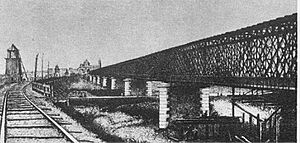
Austrian troops occupied Piacenza until 1860. In that year, a vote was held, and the city joined the Kingdom of Sardinia. When 37,089 out of 37,585 voters chose to join, Piacenza was called Primogenita dell'Unità di Italia ("First-born of the Unification of Italy") by the king. Many people from Piacenza joined Giuseppe Garibaldi's army for the Expedition of the Thousand.
In 1858, a geologist named Karl Mayer-Eymar named the Piacenzian Age of the Pliocene Epoch after deposits found near Piacenza.
In June 1865, the first railway bridge over the Po River in northern Italy was opened. In 1891, the first Chamber of Workers was created in Piacenza.
World War II
During World War II, the city was heavily bombed by the Allies. This was because of its important railway and road bridges over the Trebbia and Po rivers, and its railway yards. The historic center of the city also suffered damage. In 1944, the bridges over the Po were very important for supplying Field Marshal Albert Kesselring's Gothic Line. This line helped Kesselring's troops retreat from Italy. The railway and road bridges at Piacenza were key, along with supply depots and railway yards. In July 1944, Allied bombers flew many missions, destroying bridges and cutting roads and rail lines. By August 4, all cities in northern Italy, especially Piacenza, were isolated and heavily bombed.
In the hills and Apennine Mountains, partisans (resistance fighters) were active. On April 25, 1945, a general uprising by the Italian resistance movement began. On April 29, troops from the Brazilian Expeditionary Force entered the city. In 1996, the president Oscar Luigi Scalfaro honored Piacenza with a gold medal for its bravery in battle.
There was also a prisoner of war (POW) camp in Piacenza called Veano Camp PG 29.
Piacenza's Geography
Climate
Piacenza has a humid subtropical climate. This means it has no dry season and is always moist. Summers are hot and humid.
Main Sights
Piacenza has many historic palaces, often with beautiful gardens.
Important Buildings to See
Palaces and Other Buildings
- Piazza dei Cavalli: This is the main square, named "Cavalli" (which means "horses"). It's famous for two bronze statues of horses made by the sculptor Francesco Mochi. These statues show two Farnese Dukes of Parma, Alessandro and his son, Ranuccio I. The square is surrounded by:
- Palazzo Comunale: Also known as il Gotico, this building was started in 1281 as the town hall. Only the northern side was finished in the original plan. It has pointed battlements, pink marble arches on the ground floor, brick upper floors, and a tall central bell tower.
- Palazzo del Collegio dei Mercanti: This 17th-century building is the current town hall.
- Palazzo del Governatore: A neoclassical building.
- Palazzo Farnese: This palace was started in 1568 by Ottavio Farnese and his wife, Margaret of Parma. The design was changed in 1568 by Giacomo Barozzi da Vignola, also known as "Vignola." The Civic Museums inside Palazzo Farnese hold the city's art gallery and an Archaeological Museum. Here you can see the pre-Roman bronze Liver of Piacenza. This Etruscan model of a sheep's liver dates from the late 2nd to early 1st century BC. It has writing on its surface that explains different parts of the liver and what they mean. It was likely used to teach students about haruspicy, which was a form of fortune-telling.
- Palazzo Landi (dei Tribunali): This medieval palace was rebuilt in the 1400s. It has a Renaissance marble entrance. Today, it is the local court.
- Galleria d'arte moderna Ricci Oddi: An art museum mainly showing modern Italian painters.
- Collegio Alberoni: A Catholic school founded by Cardinal Giulio Alberoni in the 1700s. The school has an art gallery with Alberoni's own collection of tapestries and paintings from the Renaissance and Baroque periods.
Churches and Religious Sites
- Piacenza Cathedral: This is the main church of the Roman Catholic Diocese of Piacenza-Bobbio. It was built from 1122 to 1233 in the northern-Italian Romanesque style. The front, made of pink marble and gilded stone, has a gallery above three gates. Inside, the main area has frescoes by Camillo Procaccini and Ludovico Carracci. The dome was decorated by Morazzone and Guercino. The crypt has 108 Romanesque columns and holds the remains of St Justine.
- San Francesco: A 12th-century Romanesque-Gothic church in Piazza Cavalli. In the Middle Ages, it became an important civic church. Part of the old cloisters still remains. The church has a Latin cross shape. In 1848, the announcement that Piacenza would join the Kingdom of Sardinia was made from this church.
- Basilica of Sant'Antonino: This Romanesque church has a large octagonal bell-tower. It was ordered by St. Victor, the city's first bishop, in 350 CE. It holds the remains of the saint it's named after. In 1183, leaders from Frederick Barbarossa and the Lombard League met here to discuss the peace of Constance.
- San Savino: This church was started in 903 but only officially opened in 1107. The front and the porch are from the 17th-18th centuries. The main altar has a 12th-century wooden crucifix.
- Santa Maria in Campagna: This Renaissance church faces Piazzale delle Crociate ("Crusades Square"). It's called this because Pope Urban II called for the First Crusade here in 1095. The church was built from 1522–1528 to house a special wooden sculpture of the Madonna.
- San Sisto: This Renaissance church was started in the 15th century on top of an older temple. In 1513, the monks asked Raphael to paint the Sistine Madonna for their altar. In 1754, they sold this famous painting to Augustus III of Poland. It is now in Dresden.
Piacenza's Dialect
Many people in Piacenza and the surrounding area still speak Piacentino. This is a type of the Emilian dialect, which is part of the Emilian-Romagnol language. Emilian-Romagnol is different from Standard Italian. It has its own grammar and sounds, making it hard for Italian speakers to understand without learning it.
Even though some poets and writers have used Piacentino, the language has been used less and less during the 1900s. This is because the Italian language has become more common in schools.
Sports in Piacenza
Piacenza Calcio 1919 is the main football (soccer) team in the city. They have played in Italy's top league, Serie A, for eight seasons. They play at the Stadio Leonardo Garilli.
The city's other football club, Pro Piacenza 1919, went out of business in 2019.
Volley Piacenza is the main men's volleyball team. They play in Serie A1, the top league. They have won a championship, a national cup, a national supercup, and two European cups. River Volley is the main women's volleyball team and has won the national championship twice.
Rugby is quite popular in Piacenza compared to other Italian cities. Piacenza has several rugby teams, with Piacenza Rugby Club and Rugby Lyons Piacenza being the most important.
Piacenza's Food
Piacenza and its province are famous for making cured and salted pork products. The main specialties are:
- Pancetta: Rolled seasoned pork belly, salted and spiced.
- Coppa: Seasoned pork neck, with less fat than pancetta, aged for at least six months.
- Salame: Chopped pork meat flavored with spices and wine, made into sausages.
Bortellina (salted pancakes) and chisulén (fried dough) are perfect to eat with pancetta, coppa, and salame. They also taste great with cheeses like Gorgonzola and Robiola.
Pisarei e faśö is a dish made of handmade pasta and borlotti beans. It's served with a sauce made from tomato, olive oil, onion, salt, and pepper. People usually sprinkle grated Parmigiano cheese on top.
One special food from the Piacenza region is mostarda di frutta. This is fruit preserved in a sweet syrup that has a strong mustard flavor. Turtlìt (sweet dumplings) are filled with mostarda di frutta, mashed chestnuts, and other ingredients. They are served at Easter. Turtéi is a similar Piacenza dish, a type of pasta filled with spinach and ricotta cheese, or with pumpkin. Another similar dish is Panzerotti al Forno, made with pasta, ricotta cheese, and spinach.
Common foods in Piacenza include corn (often cooked as polenta) and rice (usually cooked as risotto). Both are very popular across northern Italy. Cheeses, like Grana Padano, are made in Piacenza, even though nearby Parma is more famous for its dairy products.
The hills around Piacenza are known for their vineyards. The wine made here has a special quality label called "Colli Piacentini" ("Hills of Piacenza"). The main wines are Gutturnio (red wines, both bubbly and still), Bonarda (a red wine, often bubbly and foamy), Ortrugo (a dry white wine), and Malvasia (a sweet white wine).
Famous People from Piacenza
- Giulio Alberoni (1664–1752), a cardinal and important statesman.
- Giovanni Paolo Panini (1691–1765), a painter and architect known for his detailed city views.
- Melchiorre Gioia (1767–1829), a philosopher and economist.
- Luigi Illica (1857–1919), a writer who co-wrote the stories for famous operas like La bohème, Tosca, and Madama Butterfly.
- Edoardo Amaldi (1908–1989), a physicist who helped start important scientific organizations like CERN and the ESA.
- Giorgio Armani (born 1934), a world-famous fashion designer and founder of the Armani brand.
- Nina Zilli (born 1980), a singer-songwriter who represented Italy in the Eurovision Song Contest 2012.
Sports Stars
- Giorgia Bronzini (born 1983), a cyclist who won the World Championship in women's cycling in 2010 and 2011.
- Pino Dordoni (1926–1998), an Olympic gold medalist in race walking at the 1952 Helsinki Games.
- Nicolò Fagioli, (born 2001), a football player.
- Filippo "Pippo" Inzaghi (born 1973), a World Cup-winning football player and coach.
- Simone Inzaghi (born 1976), a professional football player.
Piacenza's Sister Cities
Piacenza is connected with these cities around the world:
 Plasencia, Spain
Plasencia, Spain Togliatti, Russia
Togliatti, Russia Erfurt, Germany
Erfurt, Germany Placentia, California, U.S.
Placentia, California, U.S. Capilla de Guadalupe, Mexico
Capilla de Guadalupe, Mexico
See also
 In Spanish: Plasencia (Italia) para niños
In Spanish: Plasencia (Italia) para niños



